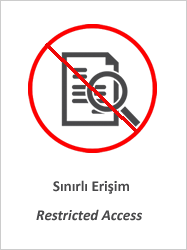Hemşirelik öğrencilerinin liderlik yönelimleri ve motivasyon düzeylerinin incelenmesi

Göster/
Erişim
info:eu-repo/semantics/embargoedAccessTarih
2012-06-19Üst veri
Tüm öğe kaydını gösterKünye
Özkan-Özdemir, Nebahat. (2012). Hemşirelik Öğrencilerinin Liderlik Yönelimleri Ve Motivasyon Düzeylerinin İncelenmesi. Yayımlanmamış yüksek lisans tezi. İstanbul : İstanbul Bilim Üniversitesi, Sağlık Bilimleri Enstitüsü.Özet
Eğitimin işlevlerinden biri toplum yaşantısının çeşitli alanlarında ve ülke yönetiminde rol alacak liderleri yetiştirmektir. 21. yüzyılın hemşirelik mesleği eğiticileri, uygulayıcıları ve yöneticilerinden hemşirelik mesleğinin gelişimine katkıda bulunmaları ve hemşirelik mesleğini geleceğe taşımak için iyi liderler yetiştirmeleri, öğrencilerin liderlik davranışlarını öğrenmeleri ve geliştirmeleri için destek olmaları beklenmektedir. Bu çalışma hemşirelik öğrencilerinin liderlik yönelimleri ve motivasyon düzeylerini değerlendirmek, çalışma sonuçları doğrultusunda öğrencilerin liderlik davranışları ve mesleki motivasyon düzeyini geliştirmeye yönelik önerilerde bulunmak amacı ile tanımlayıcı olarak planlanmış bir araştırmadır. Araştırma evrenini İstanbul’daki bir vakıf üniversitesinin hemşirelik yüksekokulunda öğrenimlerini sürdüren 2, 3 ve 4. sınıf hemşirelik öğrencileri oluşturmaktadır. Araştırma örneklemi 300 hemşirelik öğrencisinden oluşmaktadır. Veriler Öğrenci Bilgi Formu, Liderlik Yönelimleri Ölçeği ve Güdülenme Kaynakları ve Sorunları Ölçeği ile elde edildi. Verilerin istatistiksel analizi SPSS kullanılarak gerçekleştirildi. Hemşirelik öğrencilerinin İnsana yönelik liderlik alt boyut özellikleri en fazla sergilenen, Dönüşümsel liderlik alt boyut özellikleri en az sergilenen liderlik özelliği olduğu bulundu. Akademik başarısını iyi olarak tanımlayan öğrencilerin Karizmatik liderlik sergileme düzeyi akademik başarısını orta olarak tanımlayan öğrencilere göre daha yüksek bulundu. Lisans öğrenimlerini sürdüren hemşirelik öğrencilerinin İçsel güdülenme puanları (4,10 ± 0,54), Dışsal güdülenme puanları (4,22 ± 0,56) ve Mesleksel öğrenme güdülenme puanları (3,95 ± 0,44) ile Olumsuz güdülenme düzeyi (3,53 ± 0,78) yüksek bulundu. IV. sınıfta okuyan öğrencilerin Olumsuz güdülenme ve Mesleksel öğrenme güdülenme düzeyi diğer sınıfta okuyanlara göre daha yüksek düzeyde saptandı (p < 0,05). Kız öğrencilerin İçsel güdülenme ve Dışsal güdülenme düzeyleri erkek öğrencilere göre daha yüksek seviyede bulundu (p < 0,05). Hemşirelik yüksekokullarındaki müfredat programının öğrencilerin İçsel, Dışsal ve mesleksel öğrenme güdülenme düzeylerini ve liderlik becerilerini geliştirecek yönde zenginleştirilmesi önerilmektedir. One of the aims of the education is to educate the next generation of leaders who will influence the many domains of social life and will take roles and responsibilities in management of the country. Nursing professionals, clinicians and nursing managers of 21st century are supposed to contribute to nursing profession and nursing education for prospective qualified nursing leaders, and help nursing students to gain and developed their leadership behaviours. The aim of the study was to assess the nursing students’ leadership orientation and professional motivation, and to propose suggestions for improving the nursing students’ leadership behaviours and professional motivation. The study adopted an experimental design. Research population was made of 2nd class, 3rd class and 4th class students studying at nursing school of a foundation university. The study sample comprised of 300 undergraduate nursing students. Data were collected using Student Information Form and Leadership Orientation (Self) Survey and Motivation’s Resources and Problems Scale. The statistical analysis was performed using SPSS software. The current study found that the nursing students obtained higher scores from Human orientation leadership behaviours domain, and lowest scores from Transformational leadership behaviours domain. The scores of Charismatic leadership behaviours domain were higher in students who rated their academic success as good level than those who rated their academic success as average. Nursing students’ mean scores of Motivation’s Resources and Problems Scale were 4.10 ± 0.54 for Intrinsic motivation subscale, 4.22 ± 0.54 for Extrinsic motivation subscale, 3.95 ± 0.44 for Professional learning motivation subscale and 3.53 ± 0.78 for Negative motivation subscale. Negative motivation and Professional learning motivation level was higher in fourth grade students than second or third class nursing students (p < 0.05). The internal and external motivation was higher in female nursing students than male nursing students (p < 0.05). This study suggests that is vital to develop the curriculum of nursing schools for improving nursing students’ internal, external and professional learning motivation and leadership skills.

















